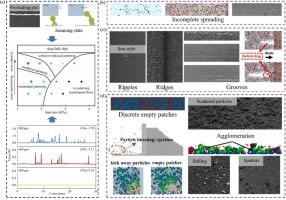基于粉末的增材制造中的粉末铺展和可铺展性:技术现状与前景
IF 4.5
2区 工程技术
Q2 ENGINEERING, CHEMICAL
引用次数: 0
摘要
粉末增材制造(AM)技术已广泛应用于各行各业。粉末铺展工艺及其可铺展性对确保最终产品和整个生产系统的质量起着至关重要的作用。本综述旨在全面了解 AM 中与粉末铺展和可铺展性相关的问题,因为这些问题对生产一致性、工艺优化和降低制造成本有重大影响。文中给出了铺展性的明确定义及其相应指标,并阐明了铺展性与流动性之间的区别。同时,对影响铺展性和铺展过程的因素(包括粉末混合物和气体环境)进行了深入探讨。讨论并总结了这些因素的内在机理,特别是临界铺展速度和铺展器前方形成的剪切带。此外,还对铺展层内的缺陷进行了仔细分类,并总结了相应的原因和机制,其中阐明了颗粒堵塞的重要性。此外,还综述了利用机器学习检测缺陷和优化铺展性的方法。最后,还强调了未来的趋势和研究机会,如将人工智能整合到现场缺陷检测和随后的铺展条件调整中。本文章由计算机程序翻译,如有差异,请以英文原文为准。

Powder spreading and spreadability in powder-based additive manufacturing: State of the art and perspectives
Powder-based additive manufacturing (AM) technology has been widely used in various industries. The powder spreading process and its spreadability play a crucial role in ensuring the quality of the final product and the overall production system. This review aims to provide a comprehensive understanding of the issues related to powder spreading and spreadability in AM, as they significantly impact production consistency, process optimisation, and manufacturing cost reduction. A clear definition of spreadability and its corresponding metrics are presented, and the difference between the spreadability and flowability is also clarified. Meanwhile, the factors influencing the spreadability and spreading process, including the powder mixture and gas atmosphere, are thoroughly reviewed. The underlying mechanisms of these factors are discussed and summarised, particularly the critical spreading speed and the shear band developed in front of the spreader. Furthermore, the defects within the spread layer are carefully classified with a summary of the corresponding causes and mechanisms, in which the importance of particle jamming is clarified. The detection of defects using machine learning and the optimisation of spreadability are also reviewed. Finally, future trends and research opportunities, such as the integration of artificial intelligence into in-situ defect detection and subsequent adjustment of spreading conditions, are highlighted.
求助全文
通过发布文献求助,成功后即可免费获取论文全文。
去求助
来源期刊

Powder Technology
工程技术-工程:化工
CiteScore
9.90
自引率
15.40%
发文量
1047
审稿时长
46 days
期刊介绍:
Powder Technology is an International Journal on the Science and Technology of Wet and Dry Particulate Systems. Powder Technology publishes papers on all aspects of the formation of particles and their characterisation and on the study of systems containing particulate solids. No limitation is imposed on the size of the particles, which may range from nanometre scale, as in pigments or aerosols, to that of mined or quarried materials. The following list of topics is not intended to be comprehensive, but rather to indicate typical subjects which fall within the scope of the journal's interests:
Formation and synthesis of particles by precipitation and other methods.
Modification of particles by agglomeration, coating, comminution and attrition.
Characterisation of the size, shape, surface area, pore structure and strength of particles and agglomerates (including the origins and effects of inter particle forces).
Packing, failure, flow and permeability of assemblies of particles.
Particle-particle interactions and suspension rheology.
Handling and processing operations such as slurry flow, fluidization, pneumatic conveying.
Interactions between particles and their environment, including delivery of particulate products to the body.
Applications of particle technology in production of pharmaceuticals, chemicals, foods, pigments, structural, and functional materials and in environmental and energy related matters.
For materials-oriented contributions we are looking for articles revealing the effect of particle/powder characteristics (size, morphology and composition, in that order) on material performance or functionality and, ideally, comparison to any industrial standard.
 求助内容:
求助内容: 应助结果提醒方式:
应助结果提醒方式:


